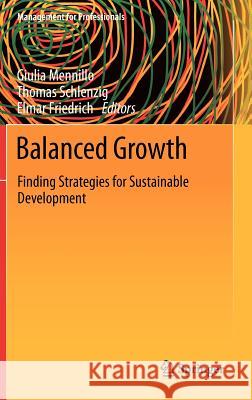Balanced Growth: Finding Strategies for Sustainable Development » książka
Balanced Growth: Finding Strategies for Sustainable Development
ISBN-13: 9783642246524 / Angielski / Twarda / 2011 / 202 str.
Balanced Growth: Finding Strategies for Sustainable Development
ISBN-13: 9783642246524 / Angielski / Twarda / 2011 / 202 str.
(netto: 191,66 VAT: 5%)
Najniższa cena z 30 dni: 192,74
ok. 22 dni roboczych
Dostawa w 2026 r.
Darmowa dostawa!
What is balanced growth? This book shows that the definitions and implications of the concept of balanced growth vary significantly among the different disciplines in economic science, but are not exclusive at all. Terms such as sustainability or balanced growth have become buzzwords. In practice, they are often a desirable vision rather than an achievable objective. Why? Doubts may arise about the extent to which such concepts are compatible with a modern market economy. Is balanced growth possible at all? Is it reasonable to accept balanced growth as a norm? Why should a balanced growth path be a desirable strategy to pursue for policymakers, managers, employees, and other societal stakeholders? Empirical evidence suggests that the actual worldwide economic growth is not balanced at all. Meanwhile, ever since the beginning of the financial and economic crisis in 2007 and its accompanying spillover effects, our globalizing world has uncompromisingly shown the flip side of its coin. Its crisis-prone character has intensified the discussion about our economic system's sustainability. Questions related to acceptable sovereign debt levels, suitable trade deficits and surpluses, firms' growth targets, resource management and efficiency have aroused high interest. What is the cause of the observed imbalances? In our opinion, this debate must involve rethinking the qualitative and quantitative dimension of our present understanding of the nature of economic growth. This book accompanies the 9th DocNet Management Symposium of the University of St. Gallen, Switzerland. It contains contributions of the symposium's panel speakers, renowned authors to the field and young researchers. The Ph.D. students' and post-doctoral association DocNet organizes the DocNet Management Symposium on a yearly basis with the goal to foster exchange between academia and practitioners.
In order to fulfill the demands of the topic s complexity we want to address three subtopics: the macroeconomic level examines the topic from a global perspective discussing growth developments across countries; the firm level deals with questions related to growth strategies of firms and the third level focuses on the management of resources by firms. In the following we outline the three book sections in detail: 1. A macroeconomic perspective The macroeconomic definition of balanced growth suggests that variables such as aggregate output, domestic demand, consumption, investment, or exports grow at the same proportional rate. In the current discussion, a balanced growth path is often considered as a necessary condition to prevent systemic imbalances. This view might imply the assumption of a "one size fits all" version of macroeconomic growth, which might be counterintuitive given the structural heterogeneity between different economies. One crucial issue of controversy in this respect is whether the concept of balanced growth is desirable or not for a modern market-oriented economy. If so, might an optimal growth path involve "some" degree of imbalance between sectors and regions? Is an acceptable level of imbalances within and across countries specifiable and quantifiable at all? 2. A firm perspective Research in firm growth has been remarked as notably slow. This finding can be attributed to a focus on research in rather "how much" growth but not on "how" to grow. Therefore, we want to address this shortcoming on growth research in our business panel discussion and book section by examining growth strategies that lead to sustainable development of firms. Particularly, we want to look on growth strategies from three different ankles. First, which factors influence the choice of a firm's particular growth strategy? Whereby strategies can be organic, acquisition, and hybrid. Second, we want to examine upcoming challenges while pursuing distinct growth strategies. Third, this book section is to provide answers to the practical value of key performance indicators to measure sustainable growth. 3. A resource perspective Dwindling resources, rising global consumption, and a rapidly increasing demand for raw materials present some of the main challenges of our times. As the United Nations stated in 1987 these megatrends underline the need for sustainable solutions that meet the needs of the present without compromising the ability of future generations to meet their own needs. In response to these problems, more and more scholars, practitioners, and politicians try to develop sustainable alternative solutions. This book section shall address the challenges connected to our current, often not-sustainable business practices and offer solutions how sustainable growth strategies in theory and practice can be achieved.











